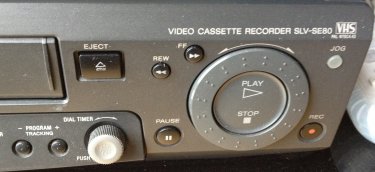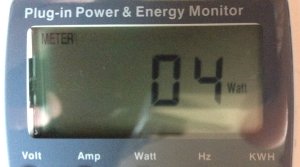Video Recorder Clocks?
Linda Anderson asks: “It seems that the automatic timer on my video does not work after the Digital Switchover, although the manual time does work. Please could you tell me if this is correct.”
The short answer is yes, that’s correct. Old video recorders used to set their built-in clock from a signal sent out with analogue TV. Once analogue was switched off, there is no longer a signal being transmitter for the video recorder to receive.
For a longer answer, and some other options, please read on…
Video Recorder Clocks and Video Plus
Thanks to Chris Healey for submitting these comments regarding use of a video cassette recorder after the Digital Switchover:
“Digital can be simple but I have had 2 problems with an analogue VCR since the changeover. Clock setting and Videoplus! I use a digibox connected to a SCART input to continue using the VCR. Yes, I can manually set the clock but as I turn things off when not in use to save power this is a bit of a chore. PDC or videoplus does not seem to work and as so many of the TV listings don’t have any PDC numbers any way it now seems pointless so now I have to manually program start & stop times.”
“What annoys me most is the clock auto set. Why oh why is there no compatible signal embedded within the digital / scart interface that can auto set the clock? In case your comment is – Buy a new digital DVD recorder etc ? — I already have one but find that tapes for time shifting programmes are much more convenient and cheaper. I feel that somebody somewhere just wants to keep selling us peasants newer and more expensive boxes — What next Super digital HD +++ ?”
“What I want is some means of auto setting the clock without manual intervention. I know that the old analogue signal contained the necessary time signals. also the new digital services have a plethora of timing information. Why not have made it compatible ? Is there a timing generator box I can buy?”
Our Response
Some makes and models of Video Cassette Recorders support an option to adjust the built-in clock automatically. They make use of a TV signal transmitted by the broadcaster (e.g. the BBC). The time signal is transmitted along with the TV picture and audio, and this can be decoded and used by the video recorder to set the clock.

Sony SLV-SE80 Video Cassette Recorder
The time signal is part of the analogue broadcast signal, and as a result, is not longer available after the UK Digital Switchover (2008-2012). This means that old analogue video recorders won’t be able to have their clocks automatically adjusted.
VideoPlus and PDC (Programme Delivery Control) for video recorders, both common in the 1990s and early 2000s also ceases once the digital switchover completes.
Replacement VCR Clock
Chris has suggested some kind of plug-in replacement clock. As far as we know, there’s nothing on the market to do this, presumably due to the lack of demand and that the majority of the UK has moved away from videotape. In theory though, it’s possible to build such a thing. Here are some notes to help:
- An old video recorder would not be capable of “looking” for time information from a SCART socket, and the SCART standard does not support this type of data. Any add-on clock would have to be connected to the RF aerial socket, and fool the VCR into thinking the signal was coming via the TV aerial
- You would need some kind of clock data. After the switchover is complete, there’s no analogue time information being sent, so you would need a new time source. You could consider making use of the MSF or DSF time signals that are used to run domestic and professional radio-controlled clocks
- Assuming you could build a clock capable of getting a time signal, you would need to convert the time data into a format that the video recorder could understand, and then “modulate” that data to be fed into the video recorder RF
No small task, but construction of such a device should be possible, however the cost of the radio receiver, RF modulator, antenna, data decoder/encoder, shielded casing and power supply is likely to exceed the cost of, say, a new PVR hard disk recorder, which is today’s replacement for the old VCR.
To overcome the problem of the clock problem, we can think of a couple of options
Alternative 1
The cheapest option would be not to switch off your VCR overnight. The clock would not need to be reset every day. Video recorders are designed to run in standby for 24 hours a day, and when video recorders were at their peak in the 1980s and 90s, people tended not to switch them off. With a VCR powered, you should only need to adjust it a couple of times a year (for BST – GMT changeover).
The issue of power consumption is interesting. To check cost, we put our Sony SLV-SE80 video recorder (pictured above) on a power meter. It consumes 4 watts in standby. This equates to around £3.80 a year if on 24 hours a day. Assuming you want to save money by powering it off overnight, you’re only saving £1.30 a year by powering it off for 8 hours a day.

Standby Power Consumption of Sony VCR
Even if it were an option to construct a time clock to set your VCR, we’d estimate a construction cost of at least £50 (approx 38 years of leaving your recorder on each night!), excluding construction time and research. Remember that the replacement clock would itself also consume power, and so will still have a cost each year.
Some may ask whether the savings of £1.20 a year outweigh the hassle of having to set your video clock manually every day…
Alternative 2
Get a PVR. These are digital TV recorders, and would allow you to record Freeview channels onto a hard drive. Here are the advantages:
- Built-in Freeview (so one box needed, not two)
- Auto-clock correct
- Electronic Programme Guide (better than VideoPlus)
- Less risk of missed shows (compared to using Freeview via SCART on a VCR)
- No messing around with tapes, tape jams or lost recordings when the tape runs out
- Most models record two channels at a time (Something you couldn’t do on a VCR)
- Series Link (Not supported by VideoPlus)
- Pause and rewind live TV (Something you couldn’t do on a VCR)
At the time of writing, you can buy a Freeview PVR for around £80 that records up to 155 hours of TV. If you still want to use tape, you can use the PVR to record, and then transfer recordings off to videotape (or DVD) at your leisure. The best bargains are to be had online – We found the Dion Freeview PVR for under £80 at Amazon, or the Bush 320GB Recorder on the High Street at Argos for £89.99

Bush 320GB Freeview PVR for under £90 at Argos